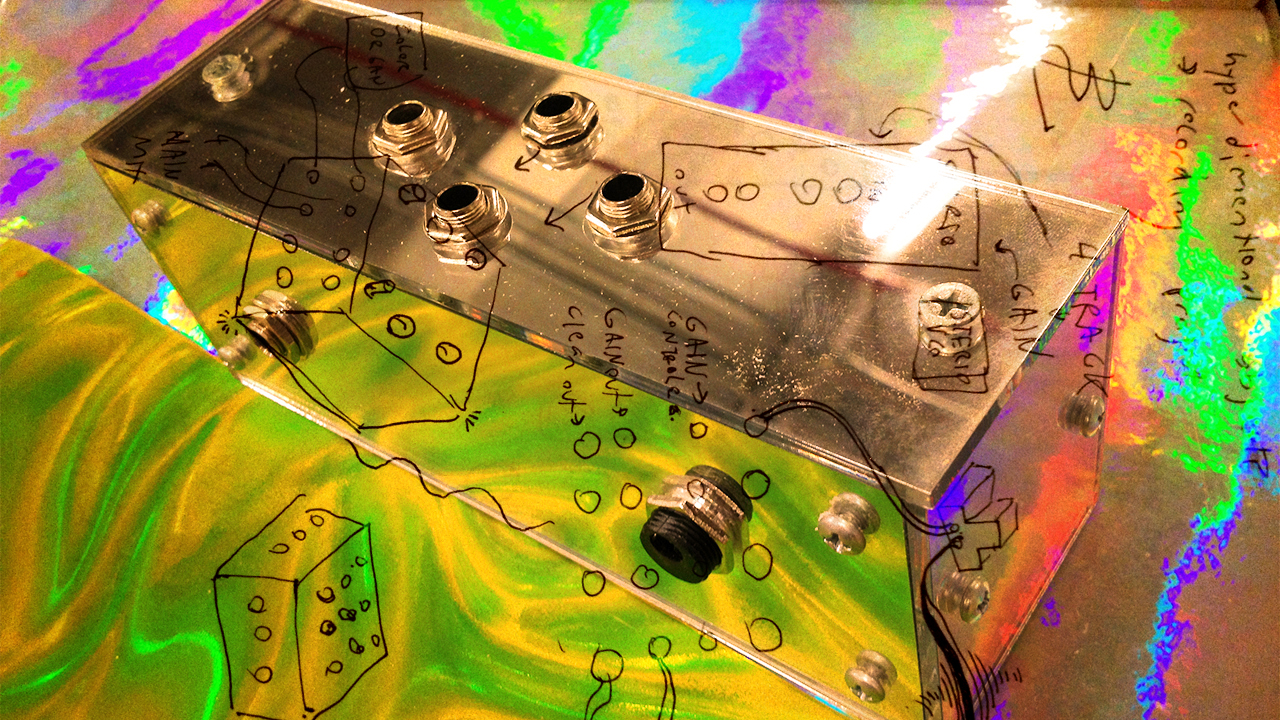ANIMAL’s feature Artist’s Notebook asks artists to show us their original “idea sketch” next to a finished artwork or project. This week Birch Cooper discusses his modular sound modules built while he was a resident at Eyebeam.
I’d like to try to use this notebook about my recent modular synth work to illustrate the interconnected, fractal nature of all of my work and the role the synth building has in it. I hope that the representation of this project will be sufficiently nonlinear as well. Because my process is shaped more or less like a fractal hyper-object, talking about this modular system beginning or end seems to give the wrong idea. I’ll try to illustrate this as well as I can ‘<};~)
My work is very interdisciplinary but hand made analogue electronics form a thread that runs through almost every aspect of my art. I avoid viewing my work as having hierarchy among any project, idea or technique. All of these act as modules that can be crystalized, shrunk down and patched in to any other “module”, while embodying an entire creative world.


These diagrams are of the modular synthesizer that I recently built, with explanations of all of the individual modules. all of the face plates are designed in Adobe Illustrator and fabricated with a laser cutter. I’ve also included early sketches that I made in my notebook, some brainstorming specifics and generalities for electronic systems.


I approached building this synthesizer as a research and development project- I didn’t know at first that the circuits would take a classical modular form. Each module started as an idea that I wanted to try out. They could have been used as an element in an interactive/generative sound/light installation, a sculpture, or they could have been combined to make more performance-oriented shredder-style synth, like the Sunstar and most of the other ones that I’ve made in the past (you can see some of them here). I decided to compile them as separate modules, to retain maximum versatility for continued testing while prioritizing functionality as a musical instrument.
I started building electronics because I was making interactive sound installations as a form of cybernetic musical composition, an idea that I’m still exploring. During the past 7 years I’ve made these systems in collaboration with my art collectives, the first being Oregon Painting Society and currently in MSHR with Brenna Murphy. If you want to go fractal, go collaborative – it’s way more insane.
Oregon Painting Society did a lot of performance-based work, so I started making instruments for us to use in our rituals. We were embodying cyber witches often and we were obsessed with brooms so at first I made a lot of broom shaped synths, all in total collaboration with OPS. The picture of me in the red room was taken by Stefano Galli at the Tate Modern, when OPS was in No Soul For Sale. The instrument that I’m holding is called the Leather Father, (Broom body by Jason Traeger of OPS). Brenna Murphy and Barbara Kinzle from OPS are in shown in the red room shredding with the first glove controlled synths that I designed, which we used on that tour. For our installation at NSFS we had interactive electronic instruments that were controlled by touching plants, the predecessor to MSHR’s interactive piece “Solar Helix”.

Here’s an early OPS plant jam video:
Rather than making technically sophisticated electronic systems in my installation work, I focus on designing transcendent interfaces- they should be simple and beautiful to use and are usually biological, cybernetic or both. I think of technology as prosthetic extensions of the brain (and sometimes life) and art as code that is inserted into human culture. This informs my criteria for what types of characteristics my interfaces and generative systems should have.

MSHRs pieces Solar Helix and Ceremonial Chamber are my two favorite interfaces that I’ve used in my work, human bodies touching and light-audio feedback respectively. MSHR uses both of these techniques in our live music.
Here’s a video of people using Solar Helix:
Almost every parameter on this modular synth can be modulated by optical sensors. I’ve attached a video and some pictures of myself making one out of a piece of driftwood. I’m totally obsessed with optical controls, especially because I’m so enamored with light-audio feedback systems. Every synth that I make now is meant to be a symbiote with color organs. I’ve attached my schematic for the color organs… something that I compiled out of several other designs.

I’ve attached some images of MSHR light sensors and and an array of modules that are the brains to our recent installation series titled Resonant Hyper Symbol Modulator, as well as some video of Resonant Hyper Symbol Modulator as an example of less conventional modular systems that I’ve designed with MSHR.


Artist’s Notebook: Sam Rolfes
Artist’s Notebook: Rebecca Patek
Artist’s Notebook: Sean Joseph Patrick Carney
Artist’s Notebook: Lincoln Correctional Facility Prisoners, Kate Levitt, Miles Pflanz
Artist’s Notebook: Lucas Ajemian
Artist’s Notebook: Kim Laughton
Artist’s Notebook: Leah Schrager




